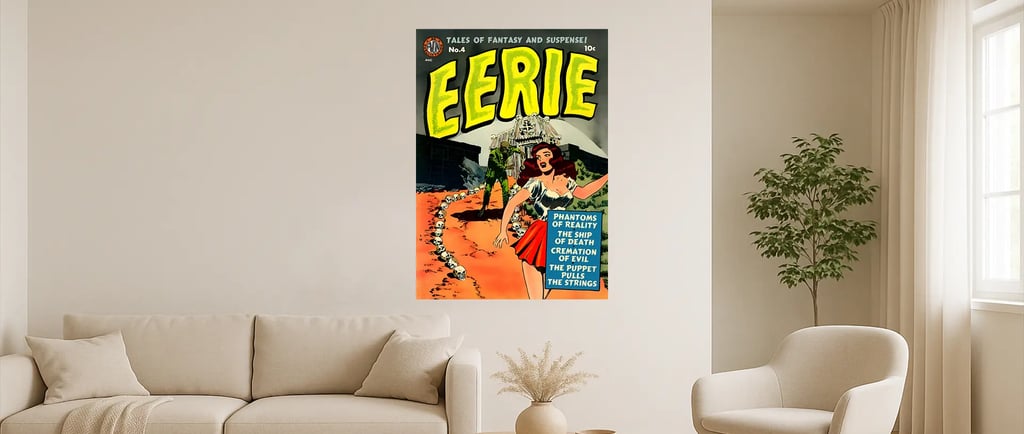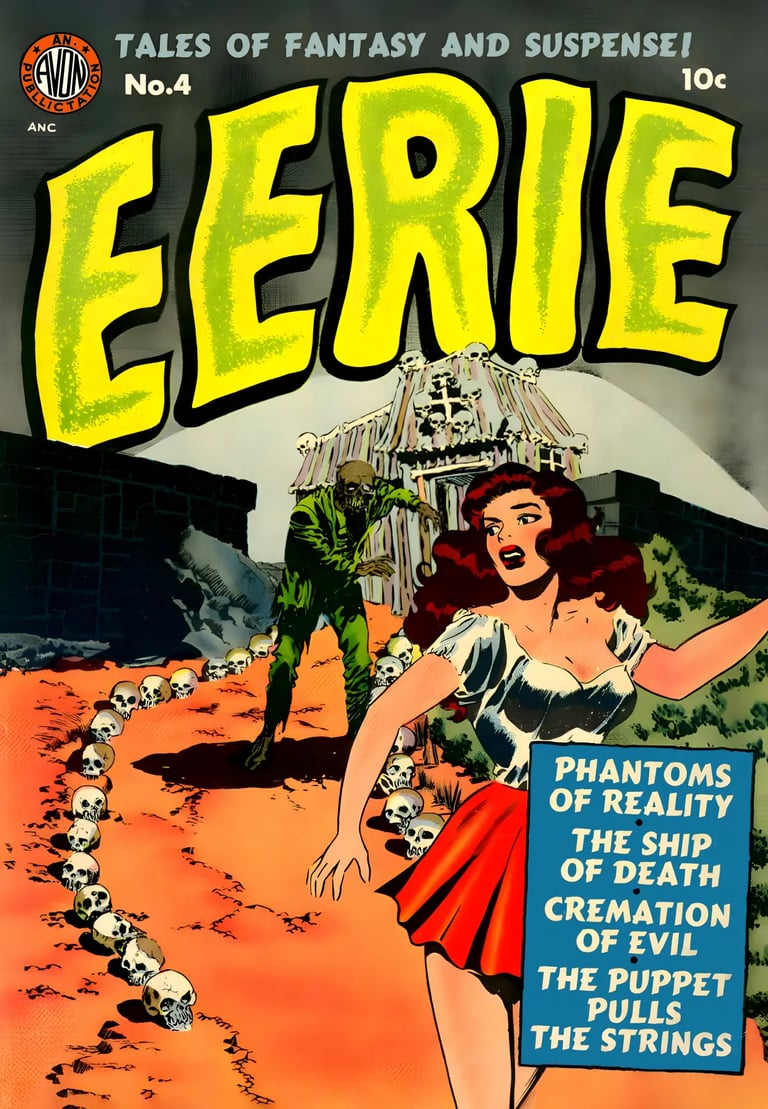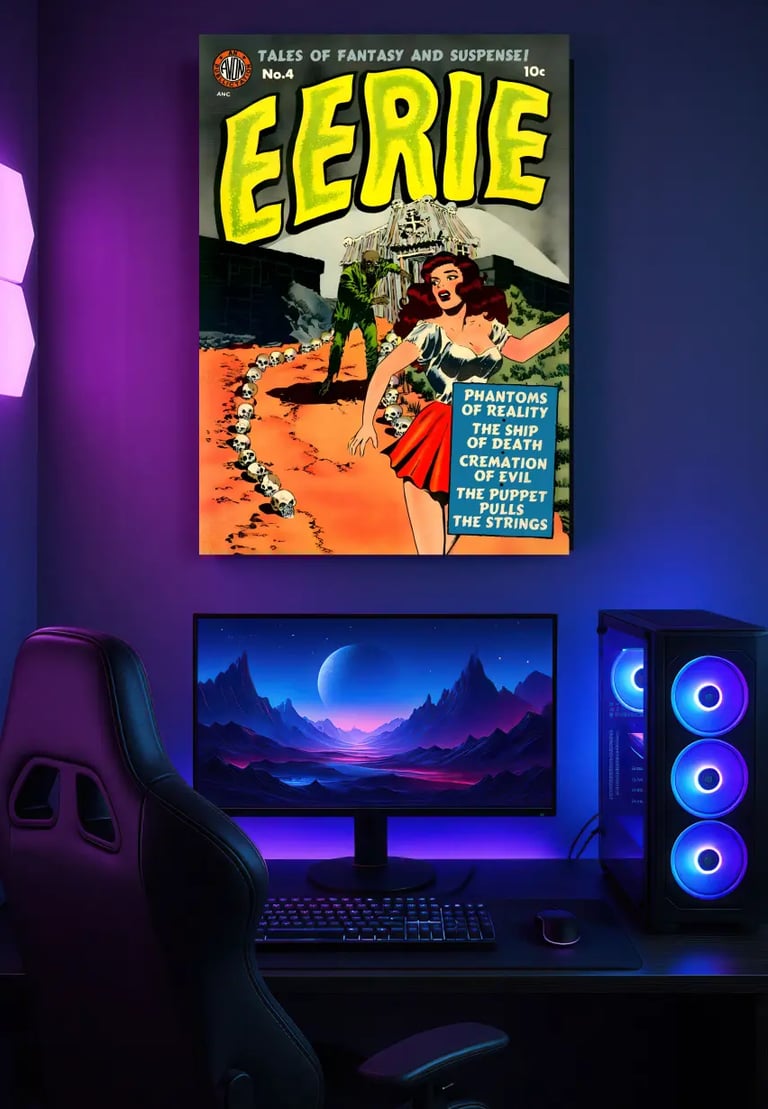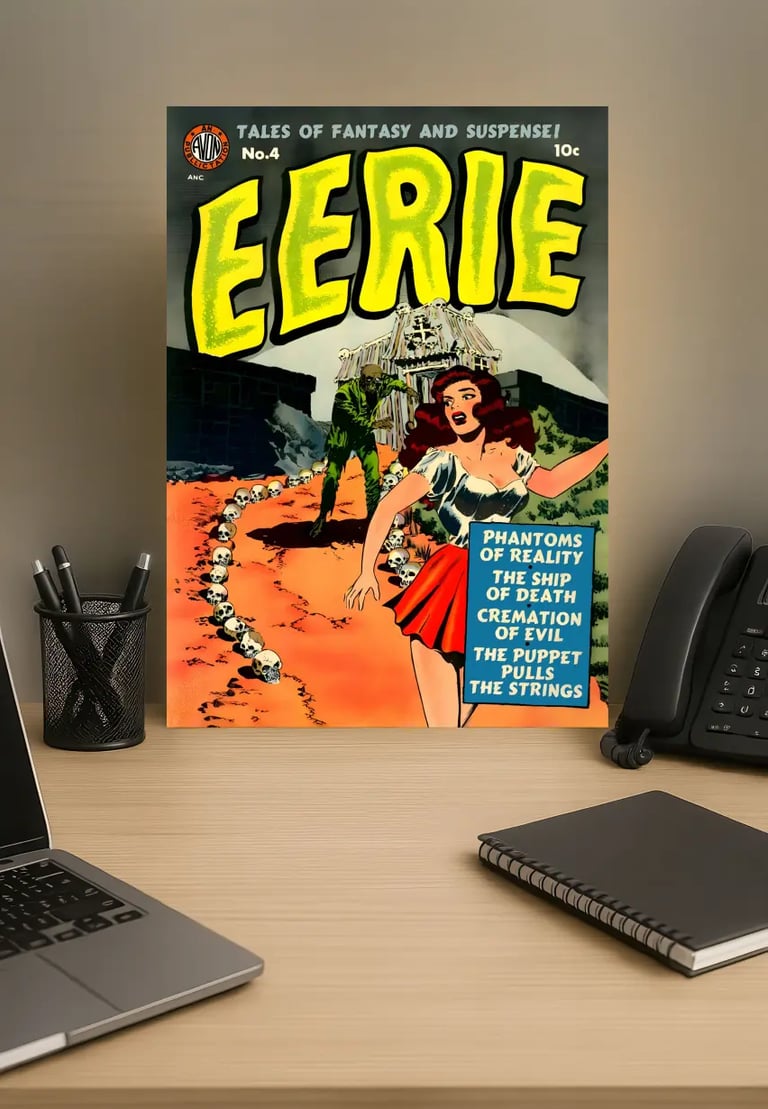Terror on a Trail of Skulls: Unearthing the Chills of Eerie 4 (1951)
Delve into the terrifying world of Eerie 4 (1951), a classic Pre-Code Horror comic from Avon. Discover the iconic cover art featuring a zombie chase along a skull-laden path and explore the suspenseful tales of phantoms, death ships, and sinister puppets that defined this chilling Golden Age gem.
Punch Prints
7/5/20254 min read


Unearthing the Chills of Eerie #4 (1951)
The Golden Age of comics (1938-1955) was a period of unrestrained creativity, especially within the burgeoning horror genre. Before the self-imposed censorship of the Comics Code Authority, titles dared to delve into the macabre and unsettling, captivating readers with tales of the supernatural and the grotesque. Among these daring publications, Eerie Comics #4, released by Avon Comics in 1951, stands out with its instantly recognizable and chilling cover, promising a descent into the darker corners of fantasy and suspense.




The Iconic Image of Fear: A Cover That Defined an Era
The cover of Eerie #4 is a masterclass in visual horror. A vibrant yet terrifying scene unfolds: a woman with wide, fear-stricken eyes and wind-swept hair flees in desperation along a winding path paved with human skulls. Hot on her heels is a shambling, green-skinned zombie, its decaying form a stark embodiment of the living dead. In the background, a skeletal structure, adorned with yet more skulls, looms ominously against a stark landscape.
This powerful imagery, characteristic of the Pre-Code Horror era, is designed to shock and thrill. The stark contrast between the vibrant colors and the gruesome subject matter is a hallmark of the time, grabbing the attention of newsstand browsers and promising a thrillingly horrific experience within. While the specific artist for this cover remains debated, its impact on the visual language of horror comics is undeniable. It’s an image that perfectly encapsulates the sensationalism and outright terror that made these comics so popular – and so controversial – in their day. This legendary Avon cover has cemented its place as a must-have for enthusiasts of vintage horror comics and retro art.




Journey into the Macabre: Exploring the Tales Within Eerie #4
Eerie #4 wasn't just about a striking cover; it delivered a quartet of suspenseful stories that lived up to the eerie promise. These narratives, typical of the Pre-Code era, often explored themes of death, the supernatural, and the consequences of tampering with forces beyond human comprehension. The advertised tales within this issue included:
“Phantoms of Reality”: This title hints at stories where the line between what is real and what is illusion becomes terrifyingly blurred, potentially involving ghosts, hallucinations, or altered perceptions of reality.
“The Ship of Death”: Evoking classic horror tropes of doomed voyages and spectral entities haunting the high seas, this story likely plunged readers into a claustrophobic world of maritime terror.
“Cremation of Evil”: Suggesting themes of fiery destruction, perhaps involving vengeful spirits, occult rituals, or the literal burning away of malevolent forces with unforeseen consequences.
“The Puppet Pulls the Strings”: This intriguing title implies a loss of control, potentially featuring possessed objects, sinister manipulators, or the terrifying realization that one is merely a pawn in a deadly game.
These stories, while often short and punchy, were designed to deliver maximum impact, utilizing vivid descriptions and shocking twists that were a hallmark of Pre-Code horror comics. They offered a raw and unfiltered exploration of fear, unburdened by the later restrictions of the Comics Code.




Avon Comics: A Bold Voice in the Golden Age
As the publisher of Eerie #4, Avon Comics played a significant role in the landscape of the Golden Age. Alongside other publishers like EC Comics, Avon was unafraid to venture into genres that pushed boundaries. Their horror titles, including Eerie, were known for their sensational covers and their willingness to explore darker themes than many mainstream comics of the time. This boldness, while contributing to their popularity, also made them targets during the moral panic that eventually led to the Comics Code Authority in 1954. Avon's contribution to the Pre-Code horror scene is a testament to a period of unbridled creativity and a willingness to explore the darker aspects of human imagination within the comic book medium.
Why Eerie #4 Still Sends Shivers Today
Despite being over seven decades old, Eerie #4 continues to fascinate and intrigue for several key reasons:
A Snapshot of a Bygone Era: It offers a direct glimpse into the uninhibited creativity of Pre-Code Horror comics, a period marked by daring themes and striking visuals that would later be heavily censored.
Iconic Artwork: The cover image remains a powerful and instantly recognizable symbol of vintage horror. Its visceral depiction of fear and the macabre continues to resonate with collectors and fans.
Historical Significance: Eerie #4 is a tangible piece of comic book history, representing a time when the medium was still finding its boundaries and exploring diverse genres with unbridled enthusiasm.
Enduring Themes: The stories within, while products of their time, often touch upon timeless fears and anxieties related to death, the unknown, and the supernatural.
Eerie #4 is more than just a collectible comic; it's a cultural artifact that embodies the spirit of a thrilling and often controversial period in comic book history. Its terrifying cover and the suspenseful tales within its pages serve as a potent reminder of the power of visual storytelling and the enduring appeal of the eerie and the macabre.
